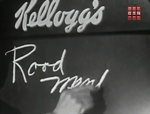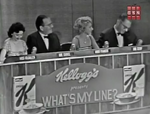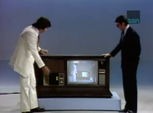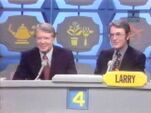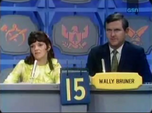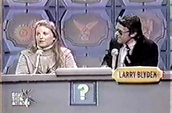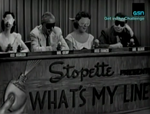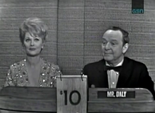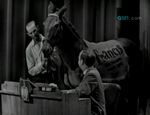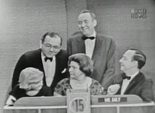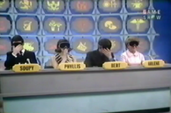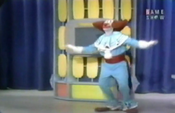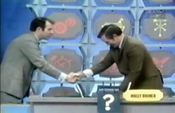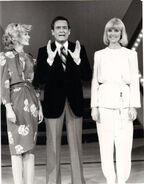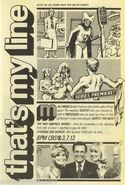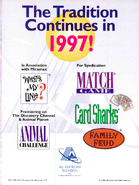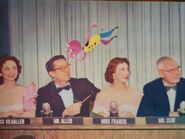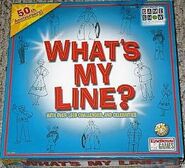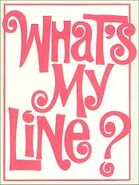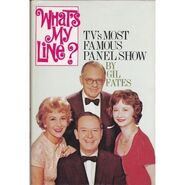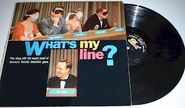| Hosts | |
|
John Charles Daly (1950-1967) | |
| Announcers | |
|
Johnny Olson | |
| Broadcast | |
| CBS: 2/2/1950-9/3/1967 Syndicated: 9/9/1968-9/3/1975 Pilot: 2000 | |
| Packager | |
| Mark Goodson/Bill Todman Productions | |
1950-1967 Opening Spiel: (Time now for everybody's favorite guessing game,) WHAT'S MY LINE? Brought to you by (insert sponsors here). And now let's all play, WHAT'S MY LINE? And now, live from New York, let's meet our What's My Line? panel! (insert introductions of panel and host John Charles Daly)
1967-1975 Opening Spiel: Let's all play...WHAT'S MY LINE? And now let's meet this week's What's My Line Panel. (insert introductions of panel and host Wally Bruner/Larry Blyden)
2000 Pilot Opening Spiel: It's...WHAT'S MY LINE? Tonight's panelists are: (insert panel) And now here's the host of What's My Line, Mr. Harry Anderson!
What's My Line? The long-running panel game show where the celebrity panelists try to figure out unusual occupations of everyday people. It's the long-running panel show that asks the question..."Is it bigger than a breadbox?"
Panelists
Regulars
Arlene Francis
Bennett Cerf
Dorothy Kilgallen
Soupy Sales
Semi-Regulars
Louis Untermeyer
Hal Block
Steve Allen
Martin Gabel
Dana Valery
Alan Alda
Bert Convy
Elaine Joyce
Ruta Lee
Meredith MacRae
Henry Morgan
Gene Rayburn
Gene Shalit
Nipsey Russell
Main Rounds
In each What's My Line? game, a contestant would enter the stage and sign in his/her name, by virtue of the host saying, "Will you enter & sign in please?" After that, he/she sat down at a desk next to the host. The game would begin by having the home audience be shown what's his/her line, and the host afterwards told the panel a clue which is usually "deals in a service" or "self-employed", something like those. Now the panelists in turn asked yes-or-no questions to the contestant which would hopefully lead to the right line. Each time the panelist in control got a yes answer, his/her turn continued, but if at any time the panelist in control got a no answer, he/she loses his/her turn and control passed to the next panelist in line; the contestant will also receive $5. Upon a no answer, the host would say the famous catchphrase "# down, # to go" (Ex: 2 down, 8 to go). Sometimes a question would have the host make a brief explanation which can lead to either a yes or no answer. A panelist can be allowed to pass his/her turn without penalty; other times the panel can call a conference. If the panel can guess the right line, they won the game, but if they got ten no answers, the contestant stumped the panel and won the game and a maximum total of $50. Often, the host would throw the cards over (end the game) when time was running short or any other reason.
In the syndicated run, the contestant would demonstrate or perform the product or service in question.
The Score Cards
In the entire original run and during Wally Bruner's stint as host, the money was printed on flip cards. The hosts would flip a card over when a panelist received a no; they would also flip all the cards over if time was running out, or any other reason. When Larry Blyden took over as host, the flip cards were replaced with slide cards built into the desk; they slid away with a press of a button. Finally, the money cards were replaced with descending numbers.
Mystery Guest
After two rounds of What's My Line? were played, a third round was played but a little differently. For this round featured the appearance of the "Mystery Guest". This was where the panelists were blindfolded so they couldn't see the guest. The mystery guest entered and signed in as usual, and that's where the game began. As usual the panel asked yes or no questions, this time to try and guess the name of the mystery challenger. What makes this round more different is that this time each panelist can only ask one question per turn hence the rule "one question at a time", and they had two to three minutes to identify the guest. While all this was going on, the mystery guest disguised his/her voice in a variety of ways.
Some mystery guests wouldn't be famous from the entertainment field, but from other walks of life; when that happens, those guests would play in the main rounds; instead of writing their names, they would write down a big "X" referring to them as Mr. or Ms. "X". One such main round mystery guest was future president Jimmy Carter.
In the original classic version, the mystery guest still scored for no answers, while in the syndicated run, the mystery guests were no longer scored. Also in the syndicated run in later years, if a panelist made a wrong guess of the guest, he/she would be free to take his/her blindfold off.
Who's Who
In the 1960s & 1970s syndicated run, whenever there was extra time, a special game was instituted called Who's Who. This was where four members of the studio audience were lined up on stage, and their occupations were printed on cards. Each panelist took those occupation cards gave each to the appropriate contestant (the ones who they thought had that occupation). Each time one panelist failed, another panelist took a turn. The game ended when the panel was stumped or if a panelist can place the occupations with the right contestants.
During What's My Line?
What's My Crime?/101 Dalmatians
In the film "101 Dalmatians" we saw a spoof of What's My Line? called "What's My Crime?". What happened was, Horace & Jasper Badun, Cruella De Vil's offbeat henchmen, were watching the show when Cruella came in to tell them to kill the 99 kidnapped puppies tonight, but they elected to continue watching the show until it was over, at which point they would then do the job. The game itself was centered around crime & the law; the contestants were all criminals and the panel was shortened to three. Horace & Jasper continued watching the show while the puppies escaped from the room; when the show ended, Horace & Jasper chased after them until Pongo & Perdy arrived.
25th Anniversary Special
On May 28, 1975 (months before the cancellation of the syndicated run), ABC aired a 90-minute special of What's My Line called "What's My Line at 25". It was hosted by producer/creator Mark Goodson alongside Arlene Francis & original host John Daly. The special chronicled the life, times, and excellent moments of the show.
After What's My Line?
What's My Part?
Sesame Street had a spoof of What's My Line? called "What's My Part?", hosted by Guy Smiley. There were two such sketches: Foot, in which the regulars Bennett Snerf (Bennett Cerf) and Arlene Frantic (Arlene Francis) were portrayed as regular people joined by Professor Hastings, who accidentally identified the Mystery Guest (Foot) merely by complaining his foot was asleep, and Nose, in which Snerf and Frantic are portrayed as noseless monsters and joined by Cookie Monster, also noseless, so naturally the Mystery Guest stumps them...and even when they remove their blindfolds they still can't identify him!
That's My Line
In 1980, CBS (the network that originally aired What's My Line?) & Goodson/Todman Productions produced & aired a special summer series called That's My Line. It was entirely based on What's My Line? except it was not a real game show; it was a simple Real People/That's Incredible-like reality show focusing on everyday people's unusual occupations. The show was hosted by Bob Barker and announced by former What's My Line? announcer Johnny Olson (who by that time became a team on The Price is Right); co-hosts for this show were Suzanne Childs, Tiiu Leek and Kerry Millerick (who joined in 1981).
1996 Proposal
A proposal was to be produced in a joint venture between All-American Television and Miramax Films. This was also the film company's first foray into television production.[1]
This version was described as "a new model" that would have blended the original features such as having a celebrity panel questions contestants in an effort to guess their occupation and also having the panel blindfolded to guess the identity of a famous person with "contemporary special effects and interactive twists".
CBS reportedly committed to six episodes for its fall 1999 schedule. However, according to Miramax TV president Billy Campbell, the deal crumbled because the network decided the show was too costly and ambitious.
2000 Pilot
A pilot for a proposed revival of the show was shot in 2000 for CBS. It was one of two proposed shows for the network at the time. The other was Survivor. This pilot was turned down for the latter show.
What's My Line? Live On Stage
Since 2004, What's My Line? came back as a live stage show hosted by J. Keith van Straaten. People who appeared on the original series along with relatives of those appeared made appearances on the live show. The show went on a brief hiatus giving host Straaten time to move from Los Angeles to New York City from July 2006 to June 2007.
Mystery Taster (The Rachael Ray Show)
On certain episodes of the popular talk show "The Rachael Ray Show", they had their own version of the Mystery Guest game called "Mystery Taster". This was where a celebrity or a group of celebrities past or present came down the elevator while Rachael stood in the corner of her kitchen so she wouldn't see. She asked interesting questions (not restricted to yes or no) hopefully to lead her to the identity of the taster. There were two rounds of Mystery Taster, the first of which being at the start of the show, and the other was later in the show. After the second round in which the identity of the Mystery Taster was eventually revealed, Rachael & the surprise guest took some time to chat at the kitchen table.
Gallery
Press Pictures
Merchandise
Board Games
The original incarnation based on the original 1950's CBS version was released by Lowell in 1955.
The second incarnation based on the 1968 syndicated version was released by Whitman in 1969.
To celebrate the shows 50th anniversary, a third version was released by Endless Games in 2001.
Books
a book based on the show was created by Gil Fates and was released by Prentice Hall in 1978, in the book the producer of the classy panel show looks back over the quarter-century run of the series. (NOTE: Original host John Daly and panelists Arlene Francis, Bennett Cerf and Dorothy Kilgallen are on the cover of the book).
Record Album
A record album based on the show was released by Dot in 1955, where audio recordings of eight "mystery guest" segments as originally seen on the show can be heard on the album.
Rating
TV-G
Music
1950
1st Open - "Melody in Moccasins" by Wilfred Burns
2nd Open - by Sacha Burland and His Orchestra
Close - Roller Coaster" by Henry Rene and His Orchestra
1968 - by Charles Fox and Score Productions
1972 - by Charles Fox and Score Productions
The Who's Who music of the 1971 version was the main from He Said She Said.
2000 - Unknown
Spinoffs
Figure it Out - a kid's version on Nickelodeon similar to What's My Line except the Secret is on a board and there are tons of surprises such as clues and slime. The panel still ask yes or no questions.
Catchphrases
"That's (insert number) down, (insert number) to go (insert panelist name)!"
"Is it bigger than a breadbox?"
"Now, will our mystery guest enter, and sign in please?"
"Mystery Guest, will you enter and sign in please?"
Tagline
"This is John Daly saying, 'Good night, (insert panelist's name), (repeat for the other panelists and back to John).' And we'll see you next time on What's My Line?" - John Daly (1950-1967)
References
Links
What's My Line? @ Pearson Television's Official Website (via Internet Archive)
Rules for What's My Line?
Jason Colflesh's What My Line? Page
The Official What's My Line Live on Stage site
YouTube Videos
The First Ever Episode of the Original What's My Line
A playing of Who's Who
Clip of the 2000 Pilot




